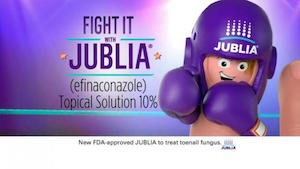Pharma has braved many a critique of its celebrity spokespeople. Just consider the Paula Deen controversy when Novo Nordisk ($NVO) tapped her for an educational campaign, or the current questions about Dr. Phil as a figurehead for AstraZeneca's ($AZN) Bydureon.
 |
| An animated ad for Valeant's Jublia |
But what about its animated mascots? They're not immune, either. The strange "Gut Guy" representing Valeant Pharmaceuticals' ($VRX) Xifaxan has triggered some visceral responses on both ends of the spectrum, from "disturbing" and "creepy" to "cute" and "cuddly"; some viewer have actually suggested a plush toy of the character.
But the FDA wonders whether drugmakers get more of a payoff from cartoon characters than real, live human beings.
In a Federal Register notice posted today, the agency says it's putting together a study of spokes-characters and how they affect viewers' perceptions of drug ads.
"[A]nimated characters are often used to grab attention, increase ad memorability, and enhance persuasion to ultimately drive behavior," the agency says in its notice, going on to question just how much cartoon figures trigger emotional responses in viewers. "The positive effects these animations induce might transfer to the brands being advertised," the notice states.
A few researchers have delved into the subject, and their findings helped inspire the FDA research. One study, published in the Journal of Advertising Research, found that drug ads featuring animated characters "led to much stronger brand recall and brand association scores," the agency notes. And it's possible that consumers discount an ad's risk statements when animated characters are buzzing, dancing or purring onscreen.
To assess viewer responses, the agency will create mock drugs for chronic dry eye and psoriasis, to contrast products with fewer side effects to cram into an ad--the dry eye drug--with those whose risk statements are longer--as with psoriasis meds. In one experiment, they'll compare viewer perceptions with an animated character that isn't human, another that's styled as a human suffer, and an actual human being. In another, they'll compare three types of animated characters, one that personifies the patient, another that represents the disease, and a third that symbolizes the drug's benefits. The idea is to test the various ads on more than 1,800 participants.
- read the Federal Register notice
Special Report: Top 10 animated characters in pharma marketing